Specimen of the Week 317: The Belemnite Fossil
By Nadine Gabriel, on 17 November 2017
Hello everyone, it’s Nadine Gabriel with another mollusc for you in this week’s Specimen of the Week. This specimen is a member of an extinct order of cephalopods that lived from the Triassic period (250-201 million years ago) through to the end of the Cretaceous period, becoming extinct around the same time as non-avian dinosaurs (~66 million years ago). These cephalopods were very common in the ancient oceans so they’re quite abundant in Jurassic and Cretaceous deposits all over the world. However, since the preservation of soft tissues is rare, it’s usually just the bullet-shaped rostrum that’s preserved. Not so in this week’s Specimen of the Week…
**The Belemnite Fossil**
Anatomy
Belemnites were squid-like animals with ten arms, each lined with 30-50 curved hooks which were used for grasping prey such as small fish, molluscs and crustaceans. Unlike modern squids, belemnites didn’t have a pair of tentacles. In case you’re wondering what the difference between cephalopod arms and tentacles are, take a look at this handy guide. Basically, tentacles only have suckers at the end and arms have suckers along their length. Like other Coleoidea (a superclass of shell-less cephalopods that includes octopus, squid and cuttlefish), belemnites had beaks, ink sacs and a tail fin.
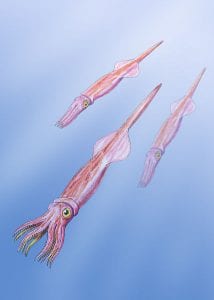
Belemnite reconstruction. Image by Dmitry Bogdanov via Wikimedia Commons, CC BY-SA 3.0
Like our Specimen of the Week, there are examples of fossils from southern England and Germany in which more than just the rostrum is preserved, such as the example below where the ink sac and arm hooks are preserved:
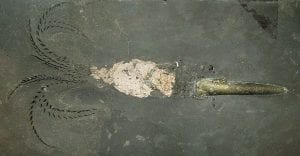
Complete belemnite fossil. Image by Ra’ike via Wikimedia Commons, CC BY-SA 3.0
The rostrum
Despite the similarities between belemnites and modern squids, the latter doesn’t have a rostrum. Belemnites get their name from this bullet-shaped structure; belemnite comes from the Greek word “belemnon” which means dart. The rostrum provided support and acted as a counterbalance to the rest of the body. At the base of the rostrum is the phragmocone, a conical structure with chambers that controlled buoyancy and balance.
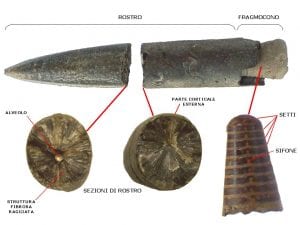
Parts of the rostrum. This shows the phragmocone (FRAGMOCONO) and cross sections of the rostrum (SEZIONI DI ROSTRO). Image by Antonov via Wikimedia Commons, public domain
The rostrum is composed of calcite, a carbonate mineral. A cross section through the rostrum shows concentric rings similar to what you would find inside a tree; each ring is thought to represent a few months. Calcite is very stable and as such, the rostrum is often the only part of the belemnite that’s fossilised. Sometimes rock outcrops are filled with hundreds of rostra. These are called belemnite battlefields and are thought to represent mass death after mating since this phenomenon is also seen in modern squid. It’s also possible to find rostra fossilised within other animals because belemnites were often eaten by marine reptiles and large fish.
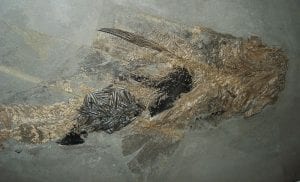
Hybodus sp. with belemnite rostra (black objects) in its stomach. Image by Ghedoghedo via Wikimedia Commons, CC BY-SA 3.0
A geologist’s best friend
Since belemnite rostra are so abundant in the fossil record, they’re used by geologists to find out about environmental conditions in the past. Carbon isotope ratios in rostra are related to levels of primary productivity (photosynthesis) and oxygen isotope ratios are used to calculate ocean temperatures. The alignment of rostra in a rock outcrop can be used to determine the palaeocurrent during sediment deposition. Also, some rock units are named after their high content of belemnites, such as the 182.7-190.8 million year old Belemnite Marls in Charmouth, England.
Nadine Gabriel is the Museum Intern at the Grant Museum of Zoology
References
https://en.wikipedia.org/wiki/Belemnitida
http://www.bgs.ac.uk/discoveringGeology/time/Fossilfocus/belemnite.html
https://ukfossils.co.uk/2012/08/28/an-introduction-to-belemnites/
https://wwwrcamnl.wr.usgs.gov/isoig/projects/fingernails/results/interpretdata.html
Natural History Museum. Belemnites – Cephalopoda: Belemnitida. Identification and Advisory Services
One Response to “Specimen of the Week 317: The Belemnite Fossil”
- 1
 Close
Close


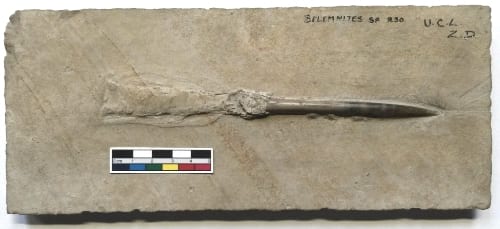
[…] Source: https://blogs.ucl.ac.uk/museums/2017/11/17/specimen-of-the-week-317-the-belemnite-fossil/ […]